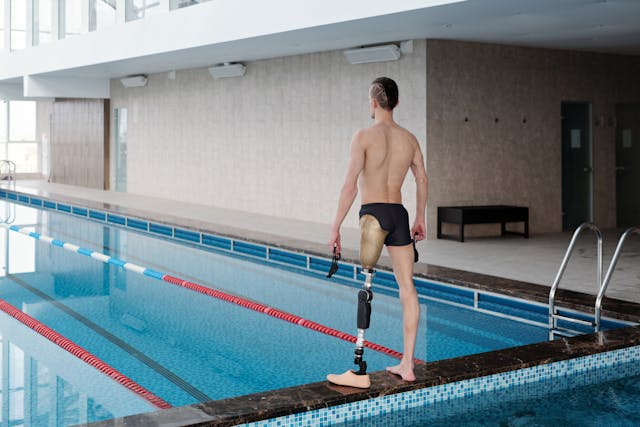Prosthetic technology is evolving at an incredible pace, giving people with limb loss more freedom than ever before. One of the biggest challenges for prosthetic users has always been water exposure and rough terrain. Traditional prosthetics are often damaged by water, sand, or extreme weather, limiting activities like swimming, hiking, or walking in the rain.
The next five years will bring a new generation of waterproof and multi-terrain prosthetics that will allow users to go anywhere without worry. With advancements in materials, AI-driven adaptability, and durability, prosthetic users will no longer have to choose between functionality and adventure.
At Robobionics, we are committed to designing high-performance, durable, and accessible prosthetic solutions that empower individuals to live without limits. In this article, we’ll explore the exciting future of waterproof and all-terrain prosthetics and how they will change lives by 2030.
1. Waterproof Prosthetics: The Freedom to Move Without Limits
For years, water has been one of the biggest obstacles for prosthetic users. Most artificial limbs are made of metal and electronic components that can rust or short-circuit when exposed to moisture. This makes everyday activities like showering, swimming, or walking in the rain a challenge.
New advancements in waterproof materials and sealed electronics are changing the game. Silicone coatings, carbon fiber, and corrosion-resistant alloys are being developed to create prosthetics that can fully withstand water without damage. Some of the latest designs feature completely enclosed motors and sensors, preventing water from seeping inside.
By 2030, waterproof prosthetics will be standard, allowing users to transition seamlessly between land and water. Whether it’s enjoying a day at the beach, swimming in a pool, or simply taking a bath without removing a limb, the future of waterproof prosthetics promises complete freedom of movement.
2. Multi-Terrain Adaptability: Moving Across Any Surface with Ease
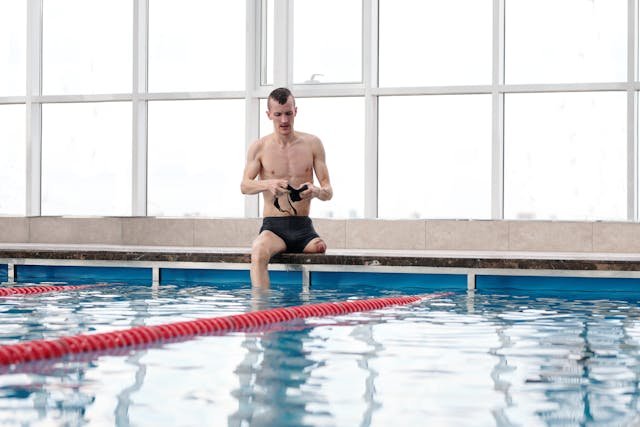
Rough surfaces, slippery floors, and uneven trails can make walking with a prosthetic challenging. Traditional prosthetic feet and legs are designed for flat, dry surfaces, but real life is rarely that predictable.
Future prosthetics will be built for all-terrain use, incorporating adaptive shock absorption, improved grip, and terrain-responsive technology. These innovations will allow users to walk on sand, gravel, wet floors, and even icy surfaces with confidence. Some prosthetics are already using AI-driven stabilization, which automatically adjusts foot positioning for balance and stability.
By 2030, prosthetic users will no longer have to hesitate before walking on rocky trails, slippery sidewalks, or muddy paths. The next generation of multi-terrain prosthetics will ensure a secure, comfortable, and stable walking experience, no matter where life takes them
3. Smart Materials: Self-Healing and Weather-Resistant Prosthetics
One of the most exciting advancements in prosthetic design is the use of smart materials that can repair themselves when damaged. Small cracks and wear-and-tear in prosthetics can weaken them over time, but future materials will be able to self-heal, extending the lifespan of artificial limbs.
Polymers with self-repairing properties and memory foam-like materials are being tested to create prosthetic limbs that automatically restore their shape and structure after minor damage. This technology is particularly useful for users who engage in outdoor sports, hiking, or physically demanding activities.
Additionally, weather-resistant coatings will protect against extreme temperatures, UV radiation, and moisture, making prosthetics even more durable. These innovations will ensure that users don’t have to worry about hot summer days, heavy rain, or freezing winters affecting their mobility.
4. AI-Powered Adaptability: Smarter Prosthetics for Any Environment
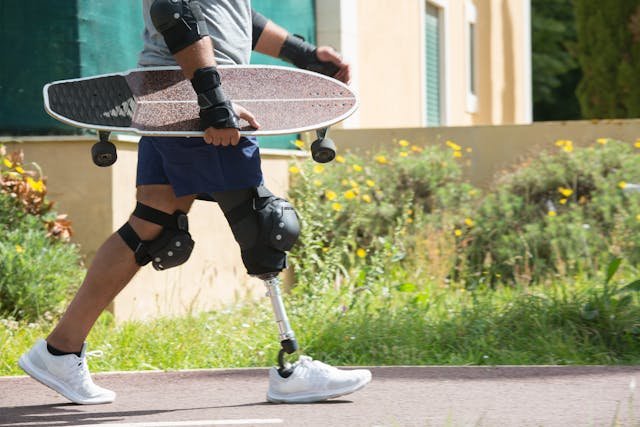
Artificial intelligence (AI) is revolutionizing prosthetics by making them more adaptive and responsive to different environments. Future waterproof and multi-terrain prosthetics will use smart sensors and AI-powered adjustments to optimize movement in real time.
For example, prosthetic legs equipped with terrain-sensing AI will detect the type of surface and adjust foot grip, shock absorption, and balance control accordingly. This means walking on slippery wet tiles, gravel, or soft grass will feel as natural as walking on a smooth floor.
AI-driven prosthetics will also help users maintain energy efficiency by adjusting movement patterns to reduce fatigue. By 2030, we can expect prosthetic limbs that feel smarter, lighter, and more intuitive, making mobility effortless across any terrain.
5. Advanced Waterproof Electronics: The Next Step in Prosthetic Control
Most high-tech prosthetics today rely on electronic components for motion control, grip adjustments, and muscle signal processing. However, these electronics are highly vulnerable to water, dust, and extreme weather.
The future of waterproof prosthetics will include fully sealed electronic systems with nano-coatings and water-resistant circuits. This will allow bionic hands, arms, and legs to function perfectly even when fully submerged in water.
New wireless charging and waterproof battery technology will also make these prosthetics more reliable. Instead of worrying about a device short-circuiting after exposure to rain or sweat, users will experience seamless performance in any condition.
6. The Role of 3D Printing in Custom Waterproof Prosthetics
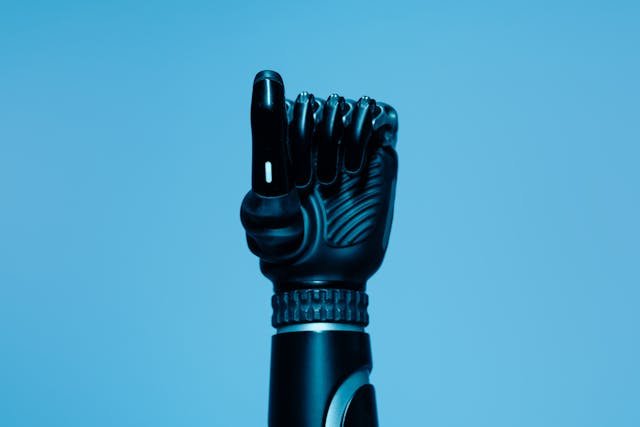
3D printing has already revolutionized prosthetic design, making it possible to create affordable, custom-fit limbs for users of all ages. In the next five years, 3D printing technology will advance further, allowing for the development of waterproof and multi-terrain prosthetics with even greater precision.
Future 3D-printed prosthetics will be made from water-resistant polymers and flexible materials that can withstand harsh conditions without compromising performance. The ability to scan and print personalized prosthetic designs will ensure that each user gets a limb perfectly suited to their lifestyle.
At Robobionics, we are already using 3D printing to create lightweight, ergonomic prosthetics like Grippy™. As this technology progresses, we will continue to develop custom, waterproof solutions that empower users to live without restrictions.
7. Sport and Adventure Prosthetics: Pushing the Limits of Performance
For athletes and adventure enthusiasts, traditional prosthetics often pose limitations when engaging in water sports, mountain trekking, or extreme physical activities. The next wave of prosthetic design will focus on high-performance models that can handle these challenges effortlessly.
Waterproof prosthetics designed for swimming, surfing, and diving will allow users to participate in sports without needing separate attachments. Meanwhile, rugged, shock-resistant prosthetics will make activities like rock climbing, skiing, and running on uneven surfaces safer and more accessible.
By 2030, we can expect specialized prosthetics designed for specific sports, featuring enhanced grip, energy-return mechanisms, and lightweight, ultra-durable materials. These advancements will break barriers and allow individuals with limb loss to pursue their passions without limitations.
8. Energy-Efficient Prosthetics: Maximizing Battery Life and Performance
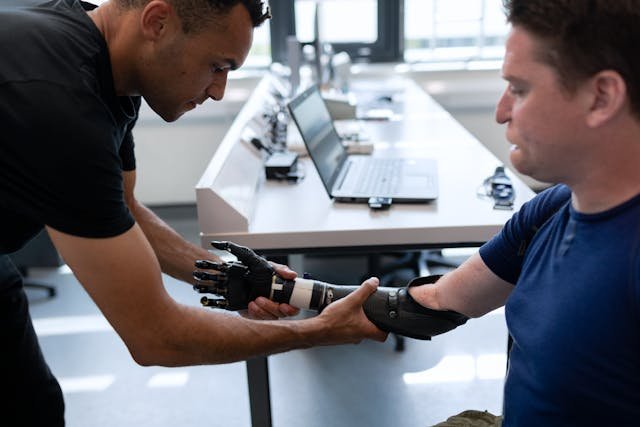
One of the biggest challenges for high-tech prosthetics is battery life. Advanced prosthetic limbs require power for movement control, grip adjustments, and AI-driven adaptability, but long battery life is essential for users who rely on their devices all day.
Future waterproof and multi-terrain prosthetics will feature energy-efficient designs, including low-power microprocessors and advanced battery technology. With the rise of solid-state batteries and graphene-based energy storage, prosthetic limbs will last longer on a single charge, reducing the need for frequent recharging.
In addition, self-charging prosthetics are being developed using kinetic energy harvesting, meaning movement itself can help recharge the battery. This could allow prosthetics to stay powered throughout the day without external charging, making them more reliable and convenient for everyday use.
9. Temperature-Resistant Prosthetics: Comfort in All Climates
Extreme temperatures can affect both prosthetic durability and user comfort. Traditional prosthetics may become too hot in the sun or too cold in winter, making them uncomfortable or even painful to wear.
New temperature-resistant materials will adapt to climate conditions, ensuring prosthetics remain comfortable in hot summers, freezing winters, or humid monsoons. Future designs will use phase-change materials (PCM), which absorb or release heat as needed, keeping the limb at an optimal temperature.
By 2030, we may also see climate-responsive prosthetic liners, which adjust their insulation based on weather conditions, preventing sweating, skin irritation, or cold-related stiffness. These innovations will make prosthetic use much more comfortable and practical for users in all environments.
10. Fully Submersible Bionic Limbs: Expanding Water Activities
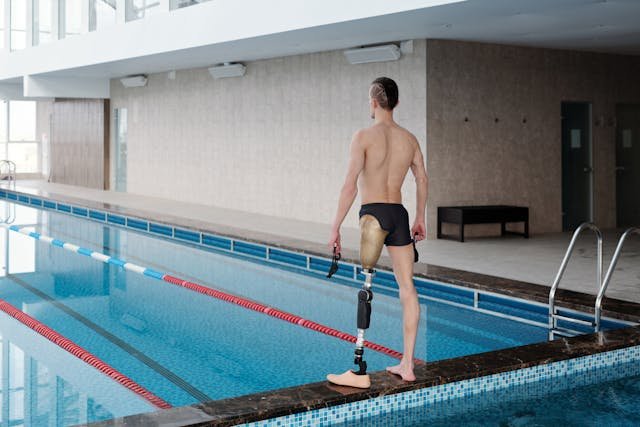
Current waterproof prosthetics often allow limited water exposure, meaning they can withstand rain, splashes, or shallow water but are not designed for deep diving or prolonged underwater use. The next step in prosthetic evolution will be fully submersible bionic limbs, allowing users to engage in diving, snorkeling, and underwater exploration.
These new designs will use pressure-resistant materials and watertight electronic enclosures to prevent malfunctions at greater depths. Some companies are also working on hydrodynamic prosthetic designs, improving underwater movement efficiency for users who enjoy swimming and water sports.
At Robobionics, we are actively researching waterproof prosthetic solutions that can handle both land and deep-water environments, ensuring that users have the freedom to explore without limits.
11. Biomechanical Efficiency: Reducing Strain on the Body
For many prosthetic users, long-term wear can cause strain on the body, particularly on the joints, back, and residual limb. Traditional prosthetics, especially those not designed for rough terrain, can create an unnatural walking pattern, leading to fatigue and discomfort.
Future prosthetics will be designed with biomechanical efficiency in mind, using lightweight, impact-absorbing materials to reduce strain. Advanced shock-absorbing mechanisms will help prevent joint stress, making movement smoother and more natural.
By 2030, we expect to see fully ergonomic designs that work with the body’s natural mechanics, ensuring that prosthetic users experience less fatigue, better posture, and improved long-term health.
12. Smart Prosthetics for Extreme Sports and Military Applications

As technology advances, waterproof and multi-terrain prosthetics will expand into high-performance applications, including extreme sports, rescue operations, and military use.
For extreme athletes, ultra-durable and high-flexibility prosthetics will provide increased mobility for activities like parkour, snowboarding, and skydiving. These prosthetics will feature shock-resistant materials, enhanced grip, and dynamic balance control, making high-impact movements safer and more precise.
In military and rescue operations, prosthetic limbs will need to withstand harsh environments, including sand, mud, and water exposure. Future designs will incorporate bulletproof materials, night vision technology, and real-time tracking sensors, giving users enhanced capabilities for tactical operations and search-and-rescue missions.
13. The Role of AI in Personalized Prosthetic Learning
Each prosthetic user has unique needs, and AI will play a crucial role in ensuring personalized adaptability. Future waterproof and multi-terrain prosthetics will come with AI-driven learning algorithms that analyze movement habits, terrain challenges, and pressure distribution to create a customized walking or gripping experience.
For example, AI-powered prosthetic feet will adjust balance and weight distribution based on the user’s stride, making every step more stable and natural. AI-driven bionic hands will also learn grip patterns, improving the ability to handle different objects in wet, dry, or uneven conditions.
With continuous machine learning updates, prosthetic limbs will improve over time, becoming more intuitive, efficient, and personalized to each user’s lifestyle.
14. Next-Generation Prosthetic Skins: Sensory Feedback and Aesthetics
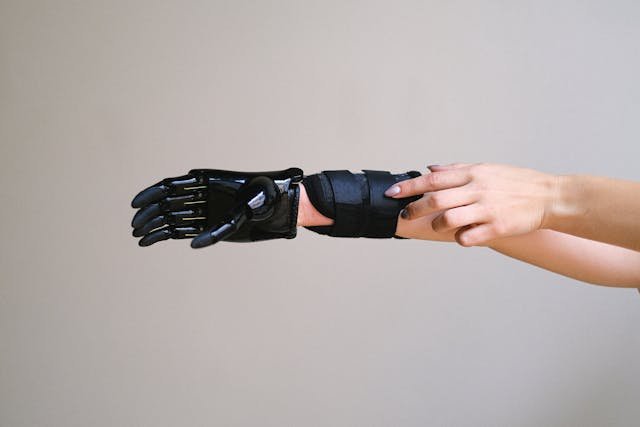
The appearance and tactile feel of prosthetic limbs have always been important for user confidence and functionality. The future will bring next-generation prosthetic skins that look, feel, and react like natural skin while being fully waterproof and durable.
New materials will integrate haptic sensors, allowing users to feel pressure, temperature, and texture in wet or dry conditions. This means a waterproof bionic hand will not only work underwater but will also detect grip pressure when holding wet or slippery objects.
Additionally, future prosthetic skins will have self-repairing capabilities, fixing minor scratches and cracks without requiring replacements. These improvements will make prosthetic limbs feel more lifelike, durable, and user-friendly.
15. Affordability and Accessibility: Bringing Advanced Prosthetics to Everyone
One of the biggest challenges with advanced prosthetic technology is cost. Many high-tech prosthetics remain expensive, limiting access for users who need them most. However, innovations in mass production, 3D printing, and AI-driven automation will help make waterproof and multi-terrain prosthetics more affordable by 2030.
At Robobionics, we are committed to affordable, high-quality solutions that empower individuals regardless of their financial situation. By leveraging local manufacturing, the “Make in India” initiative, and modular design, we ensure that cutting-edge prosthetics are within reach for more people.
The future will also see government policies, insurance coverage, and public initiatives making advanced prosthetics more accessible, ensuring that everyone, regardless of their background, can benefit from these life-changing technologies.
Final Thoughts: A Future Without Barriers
The future of waterproof and multi-terrain prosthetics is incredibly exciting. With advancements in materials, AI-driven adaptability, and smart sensors, users will no longer have to worry about water damage, unstable surfaces, or extreme conditions.
At Robobionics, we are dedicated to creating high-quality, durable, and affordable prosthetic solutions that empower individuals to live without limitations. Our Grippy™ bionic hand, along with future innovations in waterproof and all-terrain prosthetics, will provide users with unmatched freedom and confidence.
If you’re ready to experience the future of prosthetics, book a free demo with Robobionics today and take the next step toward complete mobility and independence. The world is waiting—go explore it without limits



